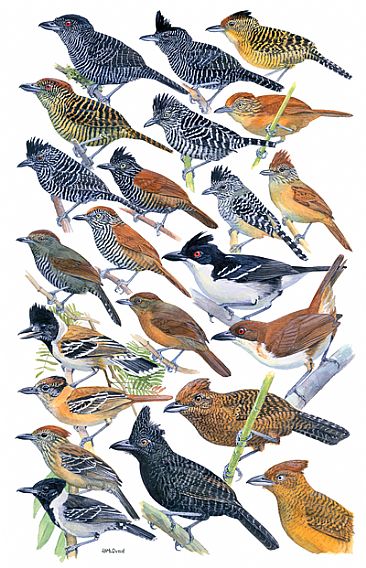
Frederickena unduligera
TAXONOMY
Frederickena unduliger Pelzeln, 1868.
OTHER COMMON NAMES
French: Batara ondй German: Mormor-Ameisenwьrger; Spanish:
Batarб Ondulado.
PHYSICAL CHARACTERISTICS
9 in (23 cm); relatively short tail, a massive hooked bill, and
brown to pale-orange iris.
DISTRIBUTION
Northwestern South America, including Colombia, Ecuador,
Peru, Bolivia, and western Amazonian Brazil.
HABITAT
Typically below 2,300 ft (700 m) in humid, lowland tropical
forest; dense undergrowth vegetation and vine-laden tree-falls
within terra firme (non-flooded) forest.
BEHAVIOR
Nonmigratory, territory-defending pairs that forage close to or
on the ground. Song is a series of 11–16, high-pitched, repeated
notes. The head crest may be raised when calling, and
the tail may wag as well.
FEEDING ECOLOGY AND DIET
Feed in dense foliage on insects and other arthropods.
REPRODUCTIVE BIOLOGY
Monogamous pairs bond for life, typically lay two eggs, and
share incubation and care of nestlings and fledglings.
CONSERVATION STATUS
Uncommon to rare species, but not formally threatened.
SIGNIFICANCE TO HUMANS
No direct significance, except for the indirect economic benefits
of bird-watching and ecotourism.
Other popular Animals
Photo Gallery of - Undulated antshrike




 Animalia Life
Animalia Life